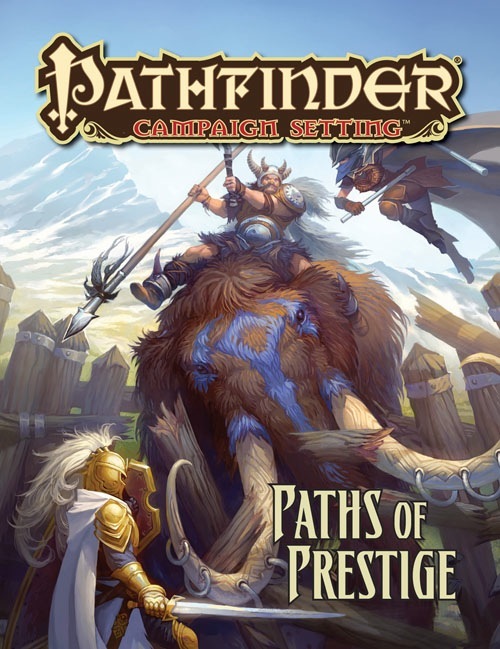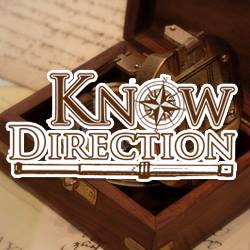Welcome to Guidance, Private Sanctuary’s source for tips and techniques for the Pathfinder Roleplaying Game, written by Everyman Gamer Alexander Augunas. Today, we’re going to be talking about Paths of Prestige.
Oh look; IT’S TUESDAY AND I’M POSTING! So yeah, you don’t get any of my GM Advice, rambling, or Iconic Designs this week, but you DO get five days of content. I try to be fair. Somewhat. Anyway, here’s Party TWO of my Unbirthday Week with another one of my favorite installments in Paizo’s campaign setting line. Remember, refer to my Reviewing Products for Fun and … Fun article if you have any questions about the format I’m using.
ONWARD!
Paths of Prestige
Paths of Prestige is a campaign setting product published by Paizo that focuses on adding new Prestige Classes to the Pathfinder Roleplaying Game. Paths of Prestige focuses heavily on the various organizations of Golarion as anchors for design. As I often GM in my home setting, I don’t often pick up products from the campaign setting line, but the lure was too great for me to exist. I can say with glee that Paths of Prestige is one of my absolute favorite Paizo products to date. Why? Read on and you’ll find out!
Crunch (Game Mechanics)
Paths of Prestige is 64 pages of beautifulness, covering roughly 30 Prestige Classes, each receiving two pages of content. The prestige classes themselves hit one of four basic premises: martial classes, skill classes, divine classes, and arcane classes. These categories are very broad; a martial class is typically a prestige class with a full base attack bonus (+1 at each level), a divine class advances divine spellcasting, and an arcane class advances arcane spellcasting, making the skill category a miscellaneous category of sorts.
It’s hard to talk in-depth about 30 prestige classes, so instead I’ll highlight some of my favorites (mechanically). Those of you who’ve read my blog know that I’m a huge fan of the Bellflower Tiller prestige class, which has an awesome ability that gives the tiller a scaling morale bonus against enemies who threaten her allies. The golden legionnaire is also fantastic; it’s a class built to buff and protect allies entirely without magic. In general, the martial and skill classes are more mechanically interesting than the spellcasting classes, though the winter witch prestige class deserves an honorable mention. It’s exactly what it sounds like; in addition to being a strong prestige class it overcomes many of the weaknesses of being a spellcasting who hyper-specializes in one specific energy type.
Mechanically, this product doesn’t attempt to solve the spellcasting “dilemma” with multiclassing and prestige classing, and it shows in the classes. Although there are some cool spellcasting classes in this book (such as winter witch) the other ones are either too specialized (like the rift warden) or have too many bonuses that simply don’t matter (like the dawnflower dissident); PCs beware. That said, the martial and skill classes in this book are phenominal; the book is worth it’s price for these classes alone, which lend themselves well to a plethora of unique and interesting builds. I award this section 4 of 5 stars; some of the spellcasting prestige classes are a bit disappointing, but the rest of the classes more than pull their weight in this book.
Flavor (Lore and Setting Information)
Although the written flavor text for each prestige class is limited, this product does something truly wonderful: it coveys flavor through mechanics. You learn a lot about what it means to be a Knight of Ozem or a Golden Legionnaire or a high-ranking leader in Zon-Kuthon’s faith simply by reading the abilities that these prestige classes grant to their members. These classes are not only mechanically sound, but flavor-wise they make for an interesting read. I award this section 5 of 5 stars.
Texture (Layout and Artwork)
As mentioned, some of the prestige classes look and feel scrunched into the space provided; I think the mammoth rider is the biggest offender of this. Despite this, Paths of Prestige has a beautifully smooth layout and flow, although compared to People of the Sands (an admittedly newer product), Paths of Prestige is a little bare; there are no fancy borders and little color aside from the character illustrations to look at. The layout is serviceable, but not extraordinary. For that reason, I award this section 4 of 5 stars; it’s great, but it’s not memorable.
Final Score & Thoughts
Crunch: 4/5 Stars Flavor: 5/5 Stars Texture: 4/5 Stars Final Score: 13/15 Stars, or 4/5 Stars
Paths of Prestige is an awesome Paizo Product; it’s one of the very best by a longshot. That said, it isn’t without it’s flaws. Paizo hadn’t perfected the spellcaster prestige class by this point and honestly, maybe they never will; almost all spellcasting classes are dreadfully ill-designed for multiclassing because of the lack of a character-wide statistic like base attack bonus. Prestige Class flavor is awesome in this book, but don’t expect to be learning anything new about the organizations that they represent. That’s one of the curious things about these classes, as a matter of fact. The prestige classes that tend to be the most mechanically powerful are the ones that have campaign-neutral themes that are attached to specific organizations: for example, Bellflower Tiller is essentially “Harriet Tubman the Prestige Class,” Knight of Ozen is essentially “Undead-Slaying Knight,” and “Mammoth Rider” is less of an organization and more of a hobby-turned prestige class. This is coming from someone who is obviously biased on the topic, but I think Paths of Prestige proves that while prestige classes might be conceptually easier to design if they’re assigned to an organization, mechanically they’re more interesting and viable options if their themes are extend beyond that specific organization.
Alexander “Alex” Augunas has been playing roleplaying games since 2007, which isn’t nearly as long as 90% of his colleagues. Alexander is an active freelancer for the Pathfinder Roleplaying Game and is best known as the author of the Pact Magic Unbound series by Radiance House. Alex is the owner of Everyman Gaming, LLC and is often stylized as the Everyman Gamer in honor of Guidance’s original home. Alex’s favorite color is blue, his favorite Pathfinder Race/Class combination is kitsune golden legionnaire; he’s tried twice to make one, but both times he’s switched to something else! The humanity!








Leave a Reply